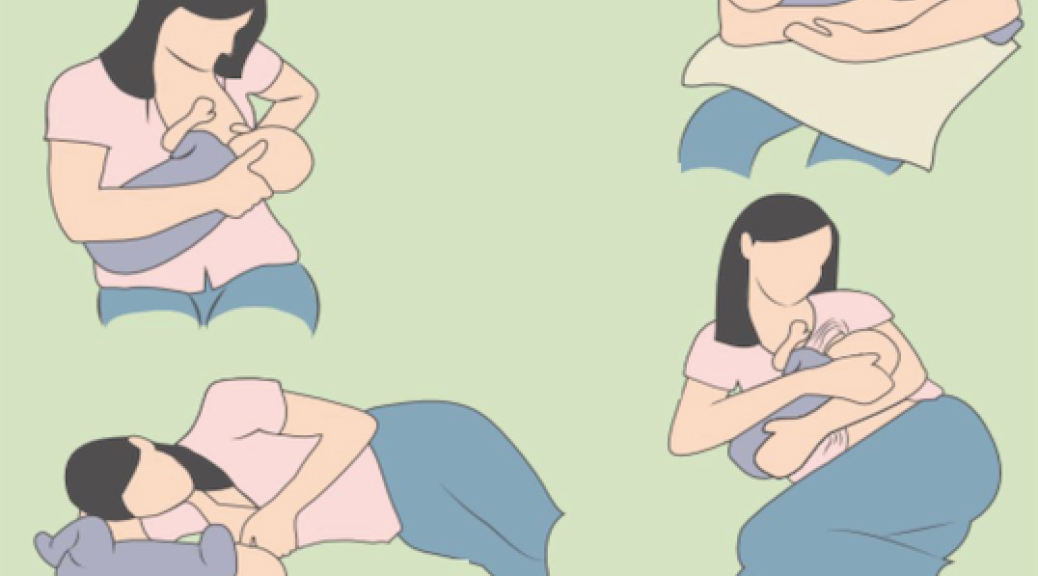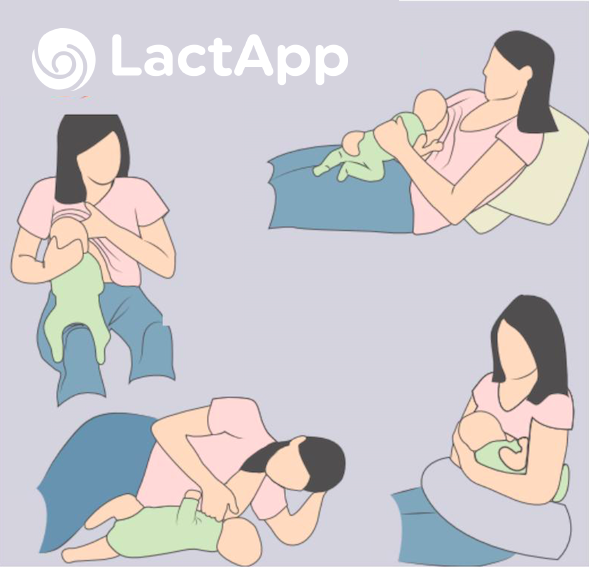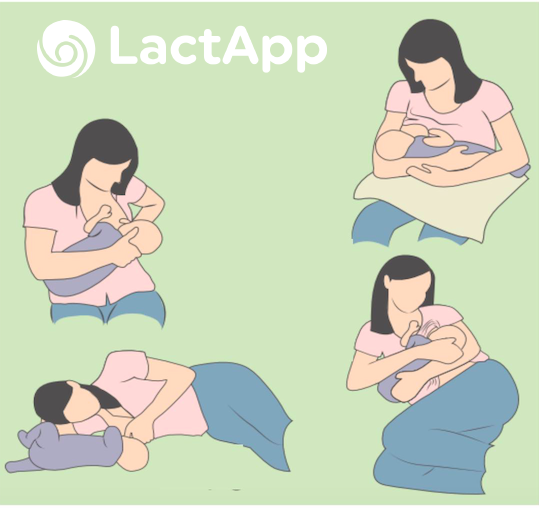
Breastfeeding positioning, attachment and latch
Positioning, attachment and a correct latch onto the breast are key to achieving a pleasant and effective breastfeeding journey. In this article, we will try to answer your most common questions.
But first of all, let’s define what we mean by each one of these concepts:
Positioning (or breastfeeding position): this is how the mother places herself to breastfeed; there are a thousand different positions, all of which are valid if the mother is comfortable.
Attachment: This is how we place the baby to breastfeed; there are also many different positions. Usually, mothers practice one or two depending on whether they breastfeed in bed, in an armchair, or if the baby has difficulty latching on. The most important thing is that the baby keeps its body aligned.
Latch or latch-on: This is the way the baby places its mouth to latch on and suckle at the breast.
What breastfeeding position is best for me?
There are no better positions than others; the “best” positioning is the one that allows your baby to achieve a good milk transfer and suckle effectively. The positioning, whatever it is, should be comfortable for the mother; place yourself comfortably to avoid shoulder or arm tension.
Most mothers tend to use two or three breastfeeding positions during their journey (and until the baby allows because there will come the point when they decide) that they combine during the day, according to their needs:
- Lying down parallel to the baby to sleep at night
- The cradle hold position is for sitting on the sofa or in an armchair
- Biological nurturing or the biological position when the mother wants to rest
- Rugby hold position if there are obstructions.
If there are no suction difficulties, all of them are equally suitable.

How do I know if the baby’s position is correct?
The position is correct when the baby’s body is aligned so that the ear, shoulder and hip form a straight line (no twisting). Years ago, the phrase “tummy to tummy” was used to explain to mothers the correct positioning. But we now know that in most cases, if the mother tries to replicate this phrase to the letter, her nipple can become damaged. Our bodies are not symmetrical, each part of our body is different, and our breasts are asymmetrical.
To understand which position will be the right for you and your baby, sit without any clothes or bra from the waist up, well reclined in a chair and observe the direction your nipples are facing. Usually, the nipples don’t point forward (try to draw an imaginary line from them in the direction in front of you). They will probably direct a little downward and to the side. Only women who have very firm breasts will have a nipple that is directed forward and straight in front.
In addition, each nipple usually points in its own direction, hence the importance of adopting a different positioning for each side of the breast. Some women say that on one breast side, the positioning is easy for them, but they don’t succeed with the opposite breast side, or it hurts. If the individual, natural direction of each nipple is not followed, the baby will latch on and pull on the nipple. This can cause sore nipples for the mother and poor milk transfer.
Again, seated and with a straight back, place the baby in front of you, place the nipple at the level of its nose (not its mouth) and wait for it to open its mouth at an angle of more than 90 degrees (as wide as possible). To achieve this, you can rest the baby’s chin on your breast, which will make it open its mouth and tilt its head backwards; these movements are necessary to achieve a good latch.
If the mother opts for the cradle hold position, she should keep in mind that her hand should be placed between the baby’s shoulder blades (on its back) and not on the baby’s bottom, so the baby will move towards the mother with its chin elevated. In the cradle hold position, it is also important that the baby’s head rests on the mother’s forearm, not on her elbow.
Do I have to use several positions to have more milk?
No, this is a myth. It is unnecessary to position the baby in many different ways to stimulate the entire mammary gland. The baby can get all the milk it needs in one given position.
But if the mother has an obstruction or blockage, it is advisable to place the baby with the chin facing the area where the lump is, so its jaw and tongue apply more force to the affected area and can eliminate the blockage sooner.

How do I know that the latch is correct?
To know that your baby is well latched, keep the following points in mind:
- The mother cannot feel any pain
- The chin and nose of the baby are touching the breast (babies do not stop breathing from being attached to close the breast, if they are uncomfortable, they will pull away to breathe)
- Baby’s lips are curled outwards (like a fish)
- Baby’s cheeks become rounded when suckling
- More areola is visible at the top of the baby’s mouth than at the bottom of the mouth
- The baby’s neck is extended
- Your nipple comes out of the baby’s mouth in a stretched form
How do I know if something is wrong?
If you feel pain, it is almost certainly a bad latch because breastfeeding is not supposed to be painful. It is also possible that some of these things may happen to you:
- The baby is not achieving a good milk transfer, resulting in little or no weight gain.
- The baby is constantly breastfeeding and never lets go on its own of the breast
- The baby sucks in the cheeks as if drinking from a straw.
- The nipple comes out of its mouth in a different shape or squeezed (in the form of the tip of a lipstick).
What should I do if my baby does not latch on well?
First, try to get your baby to latch on on its own. Most babies know how to latch onto their mother’s breast when they are not forced to do so:
- Undress your upper body and sit down reclined at an angle of about 35 degrees so your baby’s body will be lying on top of yours and will feel stable and secure.
- Undress your baby by just leaving the diaper on. It should still be asleep between your breasts, skin to skin.
- Allow your baby to wake up, slightly hold its body and allow it to move freely. You have to be attentive to the movements because sometimes they are abrupt and can jump to one side. Little by little, it will seek the breast until it latches on. During this process, it is important that you look at your baby and talk to it, encouraging and reassuring your baby if it gets angry.
- If you still have pain or discomfort, contact a lactation consultant, midwife or IBCLC, who can help you.
What should I do if my baby won’t latch on at all?
When a newborn or a few days-old baby (more about the causes of breast rejection in older babies here) does not latch onto the breast, it needs to be investigated what may be happening.
Full-term babies are born ready to suckle; if they do not so, most of the time, this is because of an unnecessary intervention on the baby that has disturbed its instincts and has prevented a good start of breastfeeding.
If your baby does not latch on, you can try the latching on suggested in the previous point. If it still does not latch on, try squeezing the breast like a sandwich to make it fit into the baby’s mouth to facilitate the latch. If this does not work, you can try to use a nipple shield of your size.
It is always better to breastfeed with a nipple shield than to pass on to exclusive pumping or have to give up breastfeeding when you are not ready to do so.
Do you have any other questions?
If you need more information about breastfeeding and motherhood, please download our free app, LactApp, for iPhone or Android. In the contact section of the app, you can find an in-app consultation channel, where our experts will answer your questions.